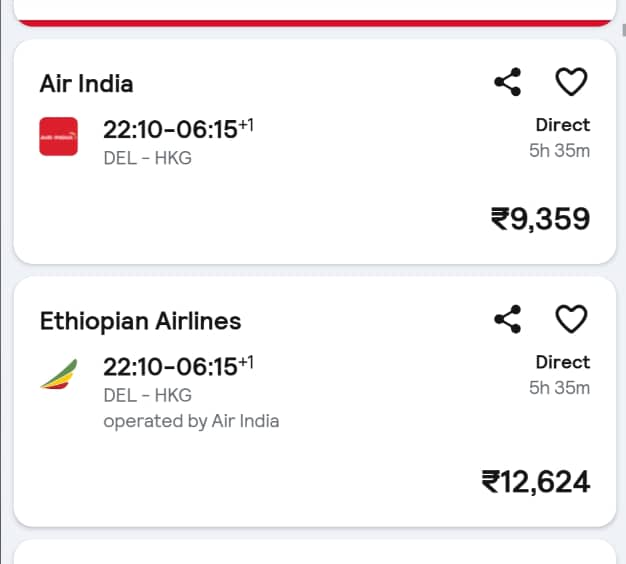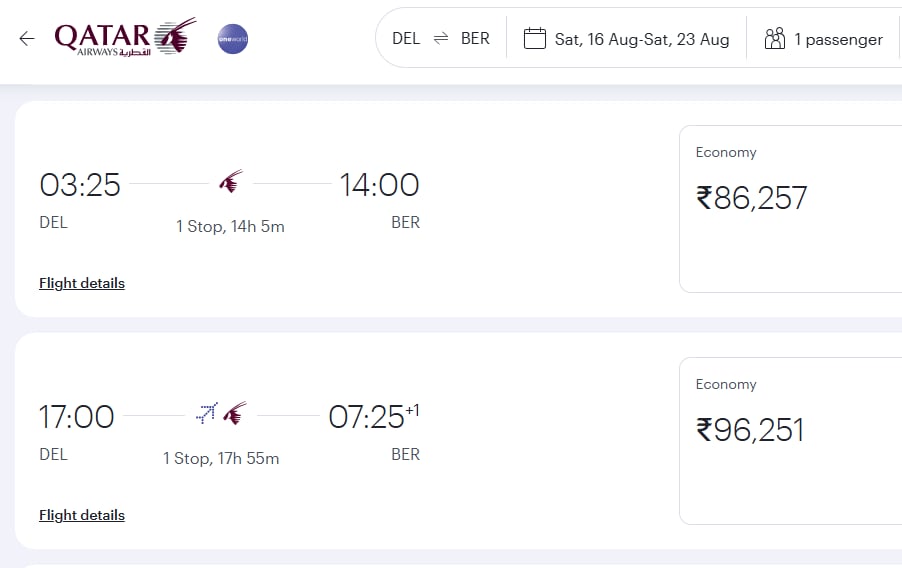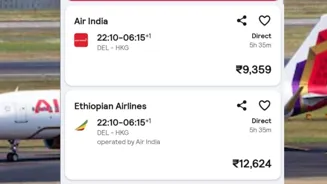A traveller looking to book a flight came across a unique listing of two different airlines from the same airports of New Delhi to Hong Kong with the same travel time and direct connectivity. Both were
operated by Air India with an exact journey duration of 5 hours and 35 minutes, too.
The cheaper option, Air India, displayed a price of Rs 9359. While the other subsequent listing of Ethiopian Airlines cost Rs 12624 for the same route. So are the mysterious sky gods at play, or is the customer getting ripped off by being offered the same product in different packaging?
This is where the codeshare flight comes into play. Before we proceed, please note that this excludes airline companies that are not part of partnerships or do not belong to the same group.
The Listing
“These both are essentially the same flight but is shown as different flight with different flight number and fare (sic),” a Reddit user wrote as they shared a screenshot of Air India and Ethiopian Airlines bound for the same route but priced differently.

(Photo shared by Honey_dp)
Both flights listed above are operated by the Air India company.
“It’s Normal”
Responding to the OP’s query, fellow travellers informed that it wasn’t out of the ordinary and was pretty standard in the commercial aviation industry.
One informed about the codeshare between two airline companies.
“It is common when booking via two different airlines who code share. The terms of the booking might also be different. For example, I generally book Lufthansa to fly between US & India. Once I book via United, even though it is Lufthansa that was the actual plane flying, the price was cheaper and the baggage allowance was less, (sic)” wrote one user in response.
While another pointed out the Star Alliance group, under which both Air India and Ethiopian Airlines were member airlines.
“As you can see, one is via a Star Alliance partner Ethiopian Airlines. Partners can list flights at prices they seem fit, no obligation to offer the same price (sic).”
Although two airline companies’ codesharing doesn’t necessarily have to be a part of the same alliance or group. For instance, Thai Airways and EVA Air have a codeshare agreement despite not falling under one group or umbrella.
Codeshare Agreement
To simplify the concept, we will peek at what IndiGo Airlines has to say about the codeshare flight.
“A codeshare flight is one in which one carrier markets and the other operates. They are a result of an agreement between two carriers to sell seats on each other’s flights with the aim to offer its customers a large variety of destinations to choose. The flight ticket would be booked on the flight number of the carrier that you have selected to travel with, however, it may be operated by another airline.”
A common example of this could be booking a seat on Qatar Airways for the New Delhi to Doha route. If your booking indicates that the Qatar Airways flight is operated by IndiGo, you will board an IndiGo flight to Doha. Qatar Airways’ job here was to help you book a seat on a flight operated by IndiGo. This works vice versa, too, as the two airline companies code-share. In this instance, Qatar Airways was the marketing carrier that sold you the code-share ticket, and IndiGo became the operating carrier.
In the example below for a round-trip from New Delhi to Berlin, one of the listings has only flights operated by Qatar Airways.
In the second listing, IndiGo operates one leg of the journey, while Qatar Airways operates all remaining flights.

(Qatar Airways)
How To Identify A Codeshare Flight?
During the flight selection, the customer will be prompted with a remark, an * or simply an airline logo to help identify the codeshare flights.
Why Is It Beneficial?
Codeshare agreements are beneficial for passengers who are suddenly exposed to a sea of flight options that make their travel plans more flexible. The agreement also enables major carriers to connect to the less-frequented or remote airports, thereby enhancing their global connectivity.
In this example of a round-trip journey from New Delhi to Berlin and back, a passenger can save a significant amount on the first listing, which includes one leg of the journey operated by IndiGo. This, despite the duration of the journeys being almost identical in both listings.

(Qatar Airways)
The codeshare agreement also extends convenience to passengers who do not have to recheck their baggage during the layovers.
Interline Agreement
Although not as comprehensive as a codeshare agreement, an interline agreement facilitates luggage handling for passengers by airlines on a given itinerary, coordinating among each other.
“An interline agreement involves airlines cooperating to handle passengers traveling on itineraries involving multiple airlines. This agreement includes provisions for baggage handling, allowing for the transfer of luggage, including trolley bags with TSA lock, between different airlines without passengers needing to collect and recheck their bags manually,” an excerpt on Safaribags.com read.
There are, however, transits and layovers where passengers are required to recheck their baggage for the onward journey.
It’s always encouraged to contact the airline(s) ahead of your journey when your itinerary has multiple flights and the layover(s) are of short duration. In some cases, a passenger may also require a transit visa if they are mandated to recheck their baggage for their connecting flight.















